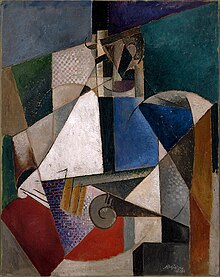| Cubist Landscape | |
|---|---|
| French: Paysage cubiste (Arbre et fleuve) | |
 | |
| Artist | Albert Gleizes |
| Year | 1914 |
| Medium | Oil on canvas |
| Dimensions | 97 cm × 130 cm (38.2 in × 51.2 in) |
| Location | Private collection |
Cubist Landscape, also referred to as Tree and River and Paysage cubiste or Arbre et fleuve, is a Cubist painting created in 1914 by the French artist Albert Gleizes. Tree and River is one of Gleizes' last pre-World War I landscapes. A comparison with earlier works such as Le Chemin, Paysage à Meudon (1911), Les Baigneuses (Gleizes) (1912), Harvest Threshing (1912) and Passy, Bridges of Paris (1912) demonstrates the artists' continuity with the theme of deep spatial vistas and wide panoramic views, though with a notable diminution of specific references to reality. The painting was reproduced in the German art and literary magazine Der Sturm (titled Baum und Fluss) October 1920.
Description
Cubist Landscape is an oil painting on canvas in horizontal format with dimensions 97 cm × 130 cm (38 in × 51 in), signed and dated Alb Gleizes, 14, lower right. Executed in a Cubist style, the work is notable in its fusing of foreground and background, the multiple perspective—also called simultaneity or multiplicity, successive views at various moments in time of the elements—the freely flowing brushstrokes, and the dark lines and arcs delineating juxtaposing color planes or surfaces.
Art historian Daniel Robbins, in his Solomon R. Guggenheim Museum Gleizes Retrospective Exhibition catalogue writes of Gleizes' work during the period:
His work was always directly engaged with environment, especially an unfamiliar one... In the works from 1914 through the end of the New York period, paintings without subject and paintings with an evident visual basis exist side by side, their difference in degree of abstraction hidden by the uniformity with which they were painted and by the constant effort to tie the plastic realization of the painting to a specific, even unique, experience. In the absence of his individual reflexes, these unique references—no matter how neutral—seem less and less in accord with the generalized nature of his austere, flat painting style.

With regard to structural composition, Cubist Landscape and other works closely related, are of critical importance, as their rhythms anticipate Gleizes' vital principles of translation and rotation (tilting planes and circular movements).
Rhythm and space, for Gleizes, are two vital conditions. Rhythm is a consequence of the continuity of certain phenomena, variable or invariable, following from mathematical relations. Space is a conception of the human psyche that follows from quantitative comparisons. This mechanism, according to Gleizes, is the foundation for artistic expression. It is therefore both a philosophical and scientific synthesis. Cubism was a means to arrive not only at a new mode of expression but above all a new way of thinking. This was, according to art historian Pierre Alibert [fr], the foundation of both a new species of painting and an alternative relationship with the world; hence another principle of civilization.
See also
References
- ^ Robbins, Daniel, The Solomon R. Guggenheim Museum, New York, Albert Gleizes, 1881-1953, A Retrospective Exhibition, 1964
- Albert Gleizes, Baum und Fluss, Gemälde, Vierfarbendruck, Der Sturm, 5 October 1920, Princeton University Blue Mountain Project
- Christopher Green, 2009, Cubism, Meanings and interpretations, MoMA, Grove Art Online, Oxford University Press, 2009 Archived 2015-07-02 at the Wayback Machine
- ^ Daniel Robbins, 1964, Albert Gleizes 1881 – 1953, A Retrospective Exhibition, Published by The Solomon R. Guggenheim Foundation, New York, in collaboration with Musée National d'Art Moderne, Paris, Museum am Ostwall, Dortmund
- Albert Gleizes, Painting and Its Laws, summary by Peter Brooke
- ^ Pierre Alibert, Gleizes, Naissance et avenire du cubisme, Aubin-Visconti, Edition Dumas, Saint-Etienne, October 1982, ISBN 2-85529-000-7
- ^ Albert Gleizes, La Peinture et ses lois, Ce qui devait sortir du cubisme, La Vie des lettres et des arts, 1922-3, 1924 in book form
External links
- Fondation Albert Gleizes
- Réunion des Musées Nationaux, Grand Palais, Agence photographique
- André Salmon, Artistes d'hier et d'aujourd'hui, L'Art Vivant, 6th edition, Paris, 1920
| Albert Gleizes | ||
|---|---|---|
| Paintings |
|  |
| Books |
| |
| Related | ||